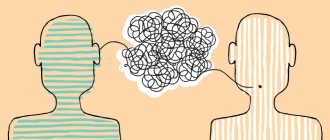Nonverbal cues in face-to-face communication
Nonverbal communication in personal relationships is the basis of communication. Words alone, without emotional reinforcement, without touches and small, but unconsciously read signals, will not get you far in family life.
Spouses may communicate little, exhausted by everyday life, children and work, but if in a dream they move closer to each other, if in rare hours of being together in the house, even when each is busy with his own business, they find a second to touch each other, smile - such the family is strong.
On the contrary, couples who publicly hug, kiss and otherwise express positive emotions at the level of conscious non-verbal signals, but do not experience warm feelings for each other, betray themselves by the absence of small gestures - momentary touches, glances, light smiles, and others often unconsciously read this information and before the spouses themselves begin to guess that something is wrong in the family.
Read also: Homemade Boiled Pork Belly
To maintain relationships, it is very important to remember about non-verbal means of communication, not to underestimate the importance of touch and expressing emotions not only through words.
Rapport and rapport building
Rapport in psychology and NLP is a special state between people when connection, mutual understanding, and trust are felt at the internal level; specific contact and the state itself when people are in this contact.
Simply put, rapport is identity with another person, similarity to him. Establishing rapport can be done by adjusting to categories according to Satir, joining, mirroring, as well as perception from the second position.
Establishing rapport
Establishing rapport is a fundamental goal in NLP. It can happen over a long period of time or very quickly. The duration of the process itself often depends on the level of the communicator. And rapport can be achieved on two levels: conscious and unconscious.
The main ways to establish rapport are: mirroring a person on a non-verbal level, as well as adjusting to basic representative systems. Nonverbal adjustment is based on reflecting the same rate of breathing, eye movements, gestures, posture, etc. Verbal takes as a basis the characteristic features of a person’s verbal behavior.
The sensory acuity of the communicator is also very important in establishing rapport, i.e. his ability to most effectively notice and track the nonverbal manifestations of another person, the external features of his behavior. People always send various signals that reflect their internal processes, and the development of sensory acuity makes it possible to “read” them, as well as determine the effectiveness or ineffectiveness of attunement with another person and the presence or absence of rapport with him.
The development of sensory acuity is a serious process, but very interesting. And its constant training will allow you to learn to track such features of people’s communication that were not previously noticed. And in order for this to become possible, you need to follow several effective recommendations:
- During communication, try to “break down” this process itself into separate components and track them.
- Monitor each person's nonverbal characteristics and reactions.
- Observe people carefully and listen to what they say.
- Watch strangers: at work, in public places, in movies and TV shows.
- Pay attention to the “little things”: breathing, rate of speech, complexion, shape of lips, tone and timbre of voice.
By improving your sensory acuity skills, you will also improve your rapport-building skills, and you will also become more deeply aware of other people and their behavior, learn to predict future interactions, recognize lies and truth, and learn to convey your own messages in a way that evokes only the reactions you need.
And the last question that we will examine in this lesson is the Milton Erickson model or, more simply, the Milton model. But, given that this topic is very voluminous and requires in-depth study, the following section of the article would be more correctly described as an introduction to the Milton model.
Language
Saying that we speak one language, for example, Russian, we little think about the fact that we actually know two languages: not only language as a means of verbal communication, but also body language - a universal complex of postures and movements with the help of which Representatives of different nationalities, cultures and races can communicate.
Unlike dictionary language, to master which you need to study the alphabet, phonetics, grammar and other components, sign language is unique: using obvious mental images and concepts, we can establish communication with both Amazonian Indians and Eskimos.
Exercises with a patient after a stroke
An important stage of rehabilitation after a stroke is the restoration of speech. This process is long and requires the patience of the family and the patient himself. You should start classes in a timely manner, since if you miss the favorable moment, the disturbances will become persistent, and speech will not be fully restored.
The correct choice of speech rehabilitation strategy requires an accurate determination of the form of dysfunction after a stroke. In practice, most of the disorders are aphasia:
- Total – observed in the first days after a stroke. The patient does not remember anything or anyone, does not speak and does not understand what they say to him.
- Motor – follows total. The patient recognizes his relatives and understands speech, but he still cannot speak. Later, the patient begins to express desires using sounds.
- Sensory – speech understanding is impaired. These are symptoms indicating damage to the part of the brain that analyzes spoken language.
- Amnestic is characterized by difficulty in naming objects for the patient. This is due to complications when choosing a word from the vocabulary. Memory capacity decreases, retention of information perceived by ear deteriorates.
- Semantic. The patient understands simple phrases and addresses, but does not perceive complex phrases.
Hand gestures when talking
In general, hand gestures can be divided into open and closed:
- Open gestures indicate trust and friendly attitude of the interlocutor. An addition can be a slightly forward body.
- Closed hand gestures in almost all cases indicate some discomfort and a person’s desire to “close up.” For example, hands placed on the elbows and “clasped” indicate the interlocutor’s unpreparedness for a direct conversation and making a decision at the moment. If a person has a ring on his finger, and he periodically touches and scrolls it, then this gesture indicates nervous tension.
Components of interaction between representatives of the opposite sex
- A flirtatious gait and preening in front of a man, demonstrated by a woman, indicate a readiness to flirt, as do dilated pupils and a long gaze (more than 10 seconds).
- A man shaking off non-existent specks of dust or thumbs in the slits of the pockets (behind the belt) of trousers will tell about his readiness to care for the woman who is interested in him.
- An intimate gaze is when the interlocutor glides from the eyes along the partner’s body and back.
Such signs are given by people unconsciously and indicate mutual attraction.
Virginia Satyr Categories
Virginia Satir was one of the world's leading psychologists and family therapists. And the basics of its work were used at the very beginning of the development of NLP. During her career, she wrote many works in these areas and also gave lectures. During her practice, she noticed that all people, as a rule, fall into one of five categories of linguistic behavior.
These types are: blaming, ingratiating, calculating, detached and balanced. They all reflect basic communication styles and provide a significant amount of data about how a person prefers to interact with others. Let's look at these categories in more detail:
| 1 | Accuser. People belonging to this category tend to look for people who can be blamed for the fact that everything is not happening as it should. They project their experiences onto others, call them different names, point fingers at them, and use stern gestures. Their main motivation is to show others their “place” and to reprimand. Blaming people are usually very lonely. |
| 2 | Ingratiating. The peculiarity of ingratiating people is that they mirror those who accuse, also wanting to shift the blame onto someone else. But they do it a little differently: despite the fact that they shift responsibility to others, they make an effort to ensure that they themselves are perceived as very pleasant and positive people. Moreover, they may even take the blame for something in order to whitewash themselves. Ingratiating people often point out cause-and-effect relationships, use a lot of nonspecific verbs (that don't say anything specific about how something was done) and modal operators (can, can't, must, must, etc.), but don't use sharp gestures. |
| 3 | Calculating. People of this type prefer to hide their emotions so as not to reveal their true reactions or intentions. They are rational, unemotional, and have self-control. Those around them often perceive them as indifferent, aloof, cold, and insensitive. They relieve themselves of responsibility by moving the conversation into a more general direction and using “you” messages, i.e. phrases that make others feel guilty. Due to their personality traits, such people often live alone. |
| 4 |
Joining and Mirroring
To begin with, it is worth noting that in NLP joining and mirroring are understood as special methods of non-verbal communication that allow for attunement with the interlocutor, the purpose of which, of course, is more effective communication and better mutual understanding.
The fundamental factor in joining and mirroring is the person’s body language, i.e. what he consciously or unconsciously does with his body during communication. To establish a non-verbal connection with a person, you need to pay attention to him (his posture, movements of his hands and head, gestures, etc.) and, so to speak, copy him. But copying can occur in two ways: appending and mirroring.
Accession is the repetition of actions performed by a person in full accordance with their characteristics.
EXAMPLE: If a person stands with his back against the wall and legs crossed, placing his right in front of his left, then you should stand in exactly the same position, leaning your back against the wall and crossing your legs, placing your right in front of your left.
Mirroring is the repetition of actions performed by a person, reflecting all their features in a mirror image.
EXAMPLE: If a person is sitting opposite you, with his right leg crossed over his left, with his right hand under his chin, and with his left hand holding the armrest of the chair, then you should sit with your left leg crossed over your right, with your left hand under your chin, and with your right hand holding the armrest of the chair .
The method of copying the physiological characteristics of human behavior can be chosen based on the behavior of the interlocutor. The attachment is more convenient to use when you are very close to the person. Mirroring is best used while you are sitting or standing opposite each other.
It is important to always remember that your desire to adjust or mirror another person should be minimal, otherwise he will suspect strangeness in your behavior, and this, in turn, will not allow you to establish attunement.
You should adapt to a person technically and carefully: if, for example, you need to move, then you should do it slowly, in small steps. During the conversation, you need to pay attention to the very rhythm in which your partner functions. If you see that he is relaxed and fully involved in the conversation, then you can safely join or mirror.
At the very beginning of communication, it is very convenient to immediately determine the leading representative system of a person - auditory, visual, kinesthetic, digital, so that later you can “encode” your message in accordance with its characteristics. This technique is good so that the interlocutor does not suspect adjustment on your part.
There is another way to veil joining or mirroring - this is by deliberately slowing down your actions or maintaining some pause between the person’s actions and your own. The meaning here is that the person himself does not notice that adjustments are being made to suit him, but his subconscious records this and gives appropriate signals.
Often, NLP practitioners resort to copying the facial expression of the person they are communicating with. This is very convenient in view of the fact that your interlocutor does not see his face at the moment, which means that he will not be able to determine that you are copying him. At the same time, his subconscious, noticing that you are experiencing the same emotions as him (after all, you have the same facial expression!) will allow you to tune in with him.
A great way to mirror a person or join him is also to copy his voice, breathing rhythm, and predicate words. But your attunement should be comprehensive, and not include one thing (copying a voice, repeating movements, etc.), because You must try completely to synchronize with your interlocutor.
It is worth mentioning the fundamental differences between joining and mirroring. The joining process is a little more complicated, because... the work of calibration (adjustment to the interlocutor) includes only the general characteristics of the person in relation to whom it is being carried out. But then you have flexibility - you can show imagination and enthusiasm in the calibration process. And mirroring, although it occurs according to a simpler scheme (specifically copying the voice, posture, tempo of speech, etc.), does not allow one to be flexible during attunement.
Therefore, before you start joining or mirroring, it is important to consider all the above features and decide on the appropriate calibration method based on this, and any attempts you make will only look natural if you do them slowly and methodically.
The next nonverbal communication technique we will consider will be Virginia Satir's categories and adjustments to them.
Nonverbal communication
So, let's look at nonverbal means of communication. To clearly understand their diverse structure, we present their classification: 1. Expressive movements (body posture, facial expressions, gestures, gait). 2. Tactile movements (handshake, pat on the back or shoulder, touching, kissing). 3. Visual contact gaze (direction of gaze, its duration, frequency of contact). 4. Spatial movements (orientation, distance, placement at the table).
In this article we will dwell in detail on the first two groups of means of nonverbal communication and try to characterize their meaning. It should be remembered that interpreting a single gesture without the totality of other body signals means misleading yourself. Therefore, before drawing specific conclusions, you need to take into account all the nuances of the interlocutor’s behavior, as well as his physical and psychological state.
The Importance of Nonverbal Communication
Nonverbal communication is an important addition to basic communication, allowing you to convey much more information to your interlocutor, increase the level of mutual understanding and make any conversation more constructive. Psychologists call 5 main functions of nonverbal signals:
- Duplication. With a gesture, facial expression or intonation, a person can repeat the main message, confirming it, making it more understandable and unambiguous.
- Contradiction. Consciously or unconsciously, a person may show that he meant the opposite. For example, when talking about his intentions, he can wink conspiratorially.
- Substitution of meaning. With your eyes and facial expressions you can not only complement the meaning, but also completely change it or demonstrate that the phrase is said in a figurative meaning.
- Addition to what was said. Certain gestures can convey additional messages. For example, a person can say that he does not want to do something, but show by his facial expression that he is tired of it.
- Strengthening meaning. Kind words can be emphasized with a friendly smile, and an emotional statement can be emphasized by hitting the table with your fist.
The Origin of Nonverbal Communication
Perception - what is it in psychology?
Non-verbal language has two types of source of origin: biological evolution and culture. Biologists have found that facial expressions when expressing emotions, most gestures and body movements in people are innate and serve as a signal for feedback.
- paleness or redness;
- enlarged pupils;
- curvature of the lips;
- blinking.
Based on intentional and unintentional communication, there are 3 nonverbal means of communication:
- Behavioral factors. Caused by a physiological reaction: sweating from excitement, trembling in case of cold or fear.
- Unintentional means. Associated with people's habits (scratching temples, swinging legs, biting lips).
- Communication signals. Conveys brief information about an object, event, or state.









